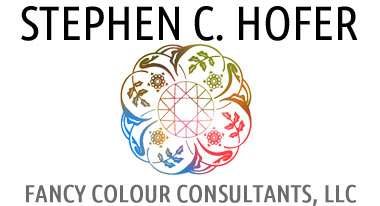Describing the colour seen in any polished coloured diamond is an ongoing challenge.
Communicating the exact colour of a polished coloured diamond to someone else requires a simple and effective method for describing the precise colour. To address this I developed the UDCL (Universal Diamond Colour Language) with the assistance of my mentor Nick Hale, former President of the Munsell Color Corp. (Hofer 1998).
The UDCL provides six (6) distinct levels of colour description, each level provides a more accurate and precise description of the colour (i.e., 1 – common colour names, 2 – main hue, 3 – secondary hue(s), 4 – lightness, 5 – saturation, 6 – numerical colour notation).

For example, the easiest way to describe the colour of any coloured diamond is to apply a common colour name (e.g., grass green, lemon yellow, autumn orange, etc). Common colour names (CCN) are simple to use and they sound romantic, making them a perfect choice for diamond promotion and sales. However, CCN represent the least precise method for describing a colour (i.e., if you want to describe a colour more accurately, you have to select higher UDCL levels).
The purpose of using a common colour name is to rapidly communicate the appearance of a specific colour, and they also enable us to “think in colour” (i.e., we use our colour memory to imagine a specific coloured object). However the common colour name that you select (to describe the colour of a diamond) must be carefully thought out, otherwise it may cause confusion in the mind of the consumer.
In other words the common colour name you select (e.g., grass green), must be similar to the coloured diamond’s actual appearance, so the diamond’s colour can be easily understood by others. Since our everyday environment is the source of colours (natural and man-made), it is here that we must begin to look for objects with typical (i.e., common) colours that mimic the colours of diamonds.
 |
 |
In my ongoing effort to educate consumers and provide a more comprehensive dialogue of colour names and colour descriptions for coloured diamonds, I have selected various coloured diamonds from my archives, and matched these gems with various coloured objects that have a similar colour appearance (i.e., common colour names).
Natural coloured diamonds literally occur in thousands of different colours and there are millions of different colours in our world, so the consumer can be endlessly entertained and intrigued by simply matching the appropriate common colour name(s) with a specific coloured diamond. As we begin to explore and understand all the different colours that diamonds offer, we soon realize that diamond is not exclusively a colourless gemstone. In fact quite the opposite, diamond is the MOST colourful gemstone on the entire planet, occurring in more distinct colours and colour varieties, than any other natural gemstone!
Keep in mind, that common colour names (UDCL-1), are just one way to describe all the different colours that nature created in diamonds. These common colour names are fun to select, exciting to talk about, and they usually create a positive response because they represent peoples personal connection with certain colours (i.e., peoples favorite colours). And that is the “secret” to unlocking the mystery surrounding coloured diamonds – i.e., developing a passion for diamond colours through increased knowledge and improved dialogue.














